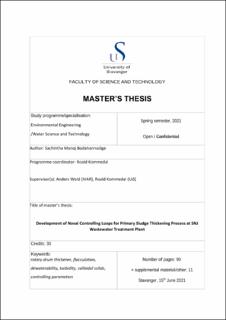| dc.description.abstract | The solid concentration of primary sludge is increased by thickening process of the wastewater treatment plant (WWTP). At SNJ WWTP, rotary drum thickener is used to thicken primary sludge and expected to obtain 5 ±1 % (Total Solids) TS from effluent. Therefore, the primary objective of this study is to optimize the thickening process in order to obtain effluent TS 5 ±1 %.
Laboratory scale experiments have been conducted on eight different days to investigate the effect of the flocculent dosage (g flocculent/ kg TS) on flocculation and dewaterability. Time to Filter (TTF) test represented dewaterability and turbidity of filtrate test represented the effectiveness of flocculation of primary sludge. The sludge characteristics (TS, TSS, turbidity of supernatant, alkalinity, conductivity, and VFA) changed each day. Hence, similar TTF or turbidity of filtrate values were not observed at constant flocculent dosage. Among the characteristics of sludge, turbidity of supernatant represented colloidal solids of the primary sludge which influenced the dewaterability and flocculation variation mostly. Consistent dewaterability was not observed even though primary sludge was mixed with secondary sludge.
The effect of operational parameters (rotational speed of thickener, backwash mechanism, mixing speed of flocculator mixer and flocculent dosage) on the thickening process at SNJ WWTP were investigated through full-scale experiments. Optimum rotational speed of thickener was identified as 4.8 rpm. The backwashing system should be operated in minimum 12 seconds to clean the whole drum filter at a rotational speed of 4.8 rpm with a maximum pause period of 1 minute between two backwash cycles. The turbulence was created by mixer of flocculator reactor required to obtain better dewaterability when influent TS was lower than 0.8%. However, better dewaterability could be obtained without using the mixer of the flocculator when influent TS was greater than 1%. Flocculent dosage was identified as the main manipulated variable of thickening process to obtain effluent TS 5 ± 1 %. Out of the five different controlling loops developed, controlling loop 3 and loop 4 were the most reliable to obtain effluent TS 5 ±1 % and economically viable controlling methods for primary sludge thickening process at SNJ WWTP. These were developed by considering influent TS and influent flowrate as feedforward parameters and turbidity of filtrate and flowrate of filtrate as feedback parameters for controlling loop 3 and loop 4 respectively. | |
